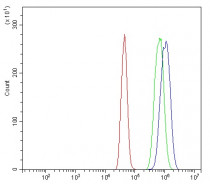ARG59200
anti-MED13 antibody
anti-MED13 antibody for Flow cytometry,ICC/IF,Western blot and Human
Overview
| Product Description | Rabbit Polyclonal antibody recognizes MED13 |
|---|---|
| Tested Reactivity | Hu |
| Predict Reactivity | Ms |
| Tested Application | FACS, ICC/IF, WB |
| Host | Rabbit |
| Clonality | Polyclonal |
| Isotype | IgG |
| Target Name | MED13 |
| Antigen Species | Human |
| Immunogen | Recombinant protein corresponding to L61-Y240 of Human MED13. |
| Conjugation | Un-conjugated |
| Alternate Names | Activator-recruited cofactor 250 kDa component; THRAP1; Thyroid hormone receptor-associated protein 1; Trap240; HSPC221; TRAP240; Mediator complex subunit 13; ARC250; Mediator of RNA polymerase II transcription subunit 13; Vitamin D3 receptor-interacting protein complex component DRIP250; Thyroid hormone receptor-associated protein complex 240 kDa component; DRIP250 |
Application Instructions
| Application Suggestion |
|
||||||||
|---|---|---|---|---|---|---|---|---|---|
| Application Note | * The dilutions indicate recommended starting dilutions and the optimal dilutions or concentrations should be determined by the scientist. |
Properties
| Form | Liquid |
|---|---|
| Purification | Affinity purification with immunogen. |
| Buffer | 0.9% NaCl, 0.2% Na2HPO4, 0.05% Sodium azide and 5% BSA. |
| Preservative | 0.05% Sodium azide |
| Stabilizer | 5% BSA |
| Concentration | 0.5 mg/ml |
| Storage Instruction | For continuous use, store undiluted antibody at 2-8°C for up to a week. For long-term storage, aliquot and store at -20°C or below. Storage in frost free freezers is not recommended. Avoid repeated freeze/thaw cycles. Suggest spin the vial prior to opening. The antibody solution should be gently mixed before use. |
| Note | For laboratory research only, not for drug, diagnostic or other use. |
Bioinformation
| Database Links |
Swiss-port # Q9UHV7 Human Mediator of RNA polymerase II transcription subunit 13 |
|---|---|
| Gene Symbol | MED13 |
| Gene Full Name | mediator complex subunit 13 |
| Background | This gene encodes a component of the mediator complex (also known as TRAP, SMCC, DRIP, or ARC), a transcriptional coactivator complex thought to be required for the expression of almost all genes. The mediator complex is recruited by transcriptional activators or nuclear receptors to induce gene expression, possibly by interacting with RNA polymerase II and promoting the formation of a transcriptional pre-initiation complex. The product of this gene is proposed to form a sub-complex with MED12, cyclin C, and CDK8 that can negatively regulate transactivation by mediator. [provided by RefSeq, Jul 2008] |
| Function | Component of the Mediator complex, a coactivator involved in the regulated transcription of nearly all RNA polymerase II-dependent genes. Mediator functions as a bridge to convey information from gene-specific regulatory proteins to the basal RNA polymerase II transcription machinery. Mediator is recruited to promoters by direct interactions with regulatory proteins and serves as a scaffold for the assembly of a functional preinitiation complex with RNA polymerase II and the general transcription factors. [UniProt] |
| Cellular Localization | Nucleus. [UniProt] |
| Calculated MW | 239 kDa |
Images (3) Click the Picture to Zoom In
-
ARG59200 anti-MED13 antibody ICC/IF image
Immunofluorescence: U2OS cells were blocked with 10% goat serum and then stained with ARG59200 anti-MED13 antibody (green) at 5 µg/ml dilution, overnight at 4°C. DAPI (blue) for nuclear staining.
-
ARG59200 anti-MED13 antibody WB image
Western blot: 50 µg of samples under reducing conditions. U2OS and MCF-7 whole cell lysates stained with ARG59200 anti-MED13 antibody at 0.5 µg/ml, overnight at 4°C.
-
ARG59200 anti-MED13 antibody FACS image
Flow Cytometry: A431 cells were blocked with 10% normal goat serum and then stained with ARG59200 anti-MED13 antibody (blue) at 1 µg/10^6 cells for 30 min at 20°C, followed by incubation with DyLight®488 labelled secondary antibody. Isotype control antibody (green) was rabbit IgG (1 µg/10^6 cells) used under the same conditions. Unlabelled sample (red) was also used as a control.








